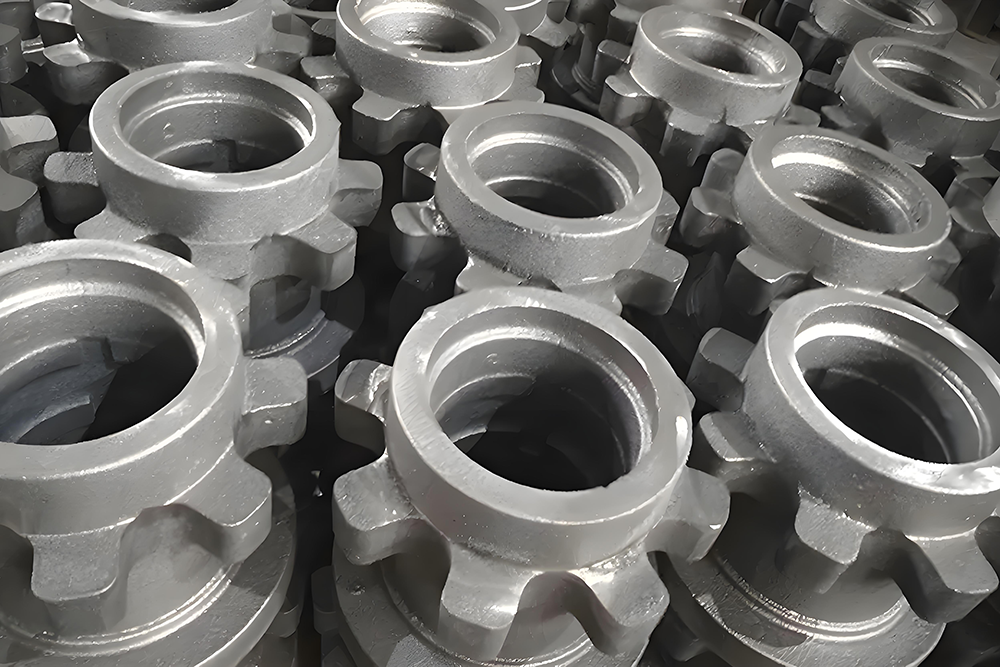Causes
Mold aspect: the gas emission of the mold material is too large, and a large amount of gas is released during pouring. If there is no time to discharge, bubbles will form on the surface of the casting. Uneven density of the mold and poor local gas discharge will also cause bubbles.
Coating aspect: the paint has poor air permeability, and the gas in the cavity cannot be discharged through the paint layer in time, and bubbles will form after accumulation. Uneven coating or excessive thickness, inconsistent gas discharge path or thermal expansion and shedding of the coating will produce inclusion pores.
Dry sand aspect: the dry sand particle size is too fine and the shape is irregular. After compaction, the porosity is low, and the gas is not easy to escape. High dust content or high water content of dry sand will increase the amount of gas generated or form water vapor, resulting in blistering.
Smelting aspect: Raw materials like pig iron and scrap steel often contain more gas, impurities, or oil stains. These decompose during smelting, generating gas that dissolves in the molten iron, increasing the likelihood of blistering. If the melting temperature is too high or the time too long, the molten iron absorbs more gas, which also leads to blistering.
In terms of casting: If the casting temperature is too high, molten metal absorbs more gas. High temperature also accelerates pattern decomposition and gas formation. Excessive casting speed causes unstable molten metal flow in the cavity. Unstable flow draws in air, forming blisters. Poor gating design causes uneven mold filling and turbulence. Improper gate location or size leads to gas entrapment.
Solution
Control the quality of the pattern: Choose pattern materials with low gas emissions, and remove dust, impurities, and release agent residues from the surface. During pattern production, control the foaming agent amount and foaming time precisely to ensure uniform pattern density.
Improve the performance of the coating: Select refractory aggregates and binders with good air permeability, and add an appropriate amount of air permeable agent. Reasonably control the binder content, optimize the curing process, and strictly control the drying temperature and time. Use a suitable coating method to control the thickness and uniformity of the coating.
Optimize the quality of dry sand: select dry sand with appropriate particle size and regular shape, reduce dust content, and control water content.
Strict smelting process: select high-quality raw materials, avoid using pig iron, scrap steel, etc. that contain gas, impurities or oil. Reasonably control the smelting temperature and time to avoid too high or too long.
Adjust the pouring process: Reasonably control the pouring temperature and speed to avoid too high temperature or too fast speed. Optimize the design of the pouring system, and reasonably set the position, number and size of the gate to ensure that the molten metal fills the mold smoothly.
The specific i pouring system adjustment measures are as follows:
Gate position selection
Avoid liquid flow impacting the mold: Avoid placing the gate directly opposite weak or complex mold areas to prevent high-speed metal flow from damaging the mold and hindering gas discharge. The molten metal should flow smoothly along the wall of the mold cavity.
Facilitate gas discharge: The gate should be positioned so molten metal pushes gas toward exhaust areas like the riser or parting surface during filling. For example, placing the gate at the bottom or side of the casting helps gas escape from the top.
Ingate design
Number and distribution: Set the number and placement of ingates based on the casting’s shape and size. For large or complex castings, increase the number of ingates to ensure even mold filling and prevent local overheating and gas buildup.
Size and shape: The ingate size should allow proper filling speed and flow rate. If too small, it may draw in gas; if too large, it can cause unstable filling. In terms of shape, trapezoidal, semicircular, etc. can be used to make the molten metal flow smoother.
Matching of runner and sprue
Reasonable proportion: The cross-sectional area of the sprue, runner and ingate should maintain a suitable proportion. Typically, the sprue’s cross-sectional area is larger than the runner’s, and the runner’s cross-sectional area is larger than the total area of the ingates. This ensures smooth molten metal flow and prevents turbulence and eddy currents.
Structural optimization: The runner should have a certain length and slope to stabilize the flow and block the slag. The length ensures the stability of the molten metal flow rate, and the slope is conducive to the floating of the slag. A buffer nest can be set at the bottom of the sprue to reduce the impact of the molten metal on the runner.
Add exhaust channels
Set exhaust holes: Place exhaust holes at the top of the casting, parting surface, and other areas where gas may accumulate. The diameter should typically be 3-5mm, with spacing based on the casting’s size and structure to ensure quick gas release.
Use exhaust sand cores: Place exhaust sand cores at the parts of the casting where bubbles are easy to form. The sand core material should have good air permeability and can lead the gas inside the cavity.
Reasonably set risers
Position and quantity: Place the riser at the final solidification area to allow shrinkage compensation and gas release. Determine the number of risers based on the casting’s structure and hot spot distribution to ensure effective venting and metal feeding.
Size and shape: The size must ensure that there is enough molten metal supply. The shape can be cylindrical, spherical, or other forms based on casting requirements. This allows smooth gas discharge from the riser. It also minimizes impact on the casting’s solidification sequence.

